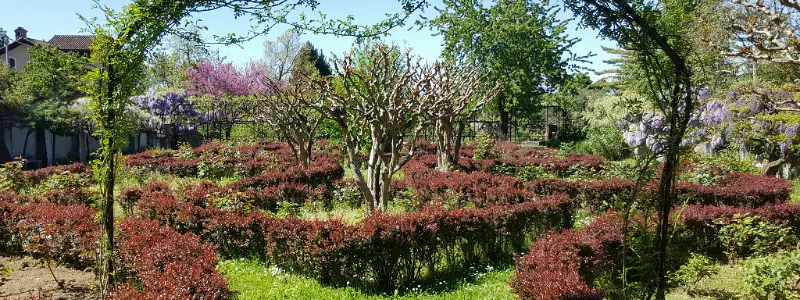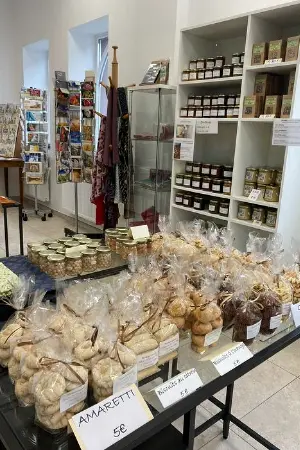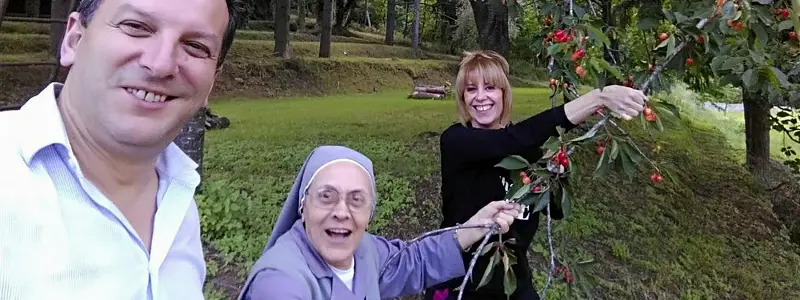The medicinal garden stands as a living pharmacy, carrying forward a tradition that once formed the backbone of European healthcare. Sisters tend to rows of echinacea, valerian, and chamomile, knowing exactly when each herb reaches its peak potency.
These plants will become the tinctures, salves, and teas that the monastery has produced for centuries, each recipe preserved in their carefully maintained herbals.
Beyond the herb garden, neat rows of vegetables stretch toward the orchard. Here, a brother guides his brethren in the art of companion planting, explaining how marigolds protect tomatoes from pests and how beans enrich the soil for future harvests. This practical knowledge, passed down through generations, merges seamlessly with lessons about spiritual growth and patience.
Hidden within this productive landscape, small meditation gardens offer spaces for solitary reflection. A rose garden, pruned to perfection, surrounds a weathered stone bench. The scent of herbs mingles with the fragrance of flowers, which wafts into the cloistered garden.
This garden, the heart of the monastery's contemplative life, demonstrates how medieval design principles remain relevant today. Its four quadrants, representing paradise, contain carefully chosen plants mentioned in scripture. Many monks walk in meditation between prayer services, finding in the garden's order a reflection of divine harmony. Others embrace the solitude and embrace the cloistered garden as a hermitic haven.

As noon approaches, the garden's workers gather the day's harvest into woven baskets. Summer squash, fresh herbs, and early apples make their way to the kitchen, where they'll become part of the community's meals or be transformed into preserves. Nothing goes to waste – even fallen leaves and spent plants return to the earth as compost, completing nature's cycle.
Visitors often find themselves transformed by time spent in these gardens. Monasteries like
Villa Crawford in Sorrento, Italy, offer
tours where guests learn about
traditional herbalism and sustainable growing practices. More importantly, they discover how working with soil and plants can become a form of prayer, a way to connect with creation's rhythms in our increasingly digital world.
The gardens also provide opportunities for extended stays, where guests can participate in seasonal activities from spring planting to autumn harvest. These experiences reveal the deep satisfaction of working in harmony with nature's cycles, a lesson that resonates long after returning home.
As the midday bell sounds, garden tools are carefully stored away. Yet even during the pause for prayer and the simple shared meal that follows, the gardens continue their quiet work of growth and renewal, demonstrating that in God's garden, every moment holds purpose.
Afternoon, From Earth to Table
The monastery's kitchen and preservation rooms pulse with activity as the afternoon sun streams through tall windows. Fresh harvests from the morning transform into time-honoured creations, each preserving summer's bounty for seasons to come.
Here, ancient recipes meet modern methods, though the fundamental processes remain unchanged since medieval times. Steam rises from copper preserving pans as a sister stirs bubbling fruit preserves. She watches for the precise moment when the berries and honey reach their perfect set, a skill passed down through generations of monastery cooks.
Nearby, rows of glass jars await their turn, soon to be filled with jewel-toned jams that will stock both the monastery's pantry and their popular gift shop.
Traditional Techniques, Timeless Flavors
In the cheese room, fresh milk from local shepherds undergoes its daily transformation. A friar presses the morning's cheese, while wheels from previous weeks age on wooden shelves.
Each cheese develops its unique character through careful turning and washing, some wrapped in herbs from the monastery garden, others brushed with ales from the brewery. The air here tells its own story of patience and tradition.
Kitchen Gardens to Culinary Treasures
The afternoon light fills the herb-drying room, where bundles of sage, thyme, and mint hang from ancient rafters. Below them, a sister carefully measures dried herbs for the monastery's signature tea blends.
Each mixture follows recipes documented in the community's medieval herbals, though now certified for modern safety standards. The scent of herbs mingles with incense from the nearby chapel, creating an atmosphere that bridges centuries.
Modern Methods, Ancient Wisdom
While respecting ancient techniques, the monastery embraces necessary modern innovations. A small laboratory adjoins the preservation kitchen, where monks test pH levels in pickled vegetables and monitor the fermentation process.
This marriage of traditional wisdom and contemporary food safety ensures that monastery products meet both spiritual and regulatory standards.

The shop of Abbaye Notre-Dame de la Paix, Chimay
As the afternoon progresses, visitors gather in the monastery shop, drawn by the aroma of fresh baking and herb-infused products. They discover shelves lined with:
- Artisanal preserves made from monastery-grown fruit
- Herbal teas blended for both pleasure and wellness
- Aged cheeses that reflect local terroir
- Traditional remedies prepared according to ancient recipes
- Fresh bread still warm from the ovens
The monastery's commitment to sharing knowledge extends to its kitchen practices. Regular workshops invite guests to learn traditional food preservation techniques, from bread baking to cheese making. Participants work alongside community members, discovering how these age-old processes can enrich their own lives.
A monk pauses from preserving to explain: "When we transform these simple ingredients, we participate in a tradition that has nourished both body and soul for centuries. Each jar of preserves, each wheel of cheese carries this legacy forward."
As afternoon light softens, the day's production winds down. Fresh products move to storage rooms or shop shelves, while others begin their patient journey of ageing and fermentation. The kitchen fills with the scent of evening bread baking, a final burst of activity before Vespers calls the community to prayer once again.

For visitors seeking a deeper connection with these traditions, the monastery offers
culinary retreats where guests can immerse themselves in the rhythms of monastic food production.
They leave not just with new skills, but with a profound appreciation for how food preparation can become a form of meditation, a way to connect with centuries of wisdom while creating something uniquely meaningful.
Evening, Community and Completion
As shadows lengthen across ancient stone walls, the monastery transitions into its evening rhythm. The day's labours wind down while bells call the community to Vespers, their resonant tones drawing both residents and guests toward the chapel's welcoming warmth.
Vespers transforms the chapel into a haven of gentle light and Gregorian chant. Monks and nuns file into their wooden choir stalls, their voices rising in harmonies that have echoed through these walls for centuries. Visitors often find this evening service particularly moving, as golden sunlight filters through stained glass windows and incense weaves delicate patterns in the air.
After prayers, the community processes to the refectory where the day's harvest appears transformed on wooden tables. Tonight's simple yet nourishing meal showcases the monastery's own produce: fresh bread still warm from the afternoon baking, cheese aged in the cellar, and vegetables from the garden dressed with herbs and monastery-pressed olive oil.
Though the meal occurs in contemplative silence, the shared experience creates a palpable sense of community.
As daylight fades, the community tends to final tasks with practised efficiency. In the workshop, a friar checks on ageing cheeses one last time, while a nun prepares tomorrow's sourdough starter.
The gardeners bring in tools and close the greenhouse, pausing to appreciate the evening blooms that perfume the cooling air.
The monastery shop welcomes its final visitors of the day, some of whom have participated in afternoon workshops or garden tours. They leave with carefully wrapped packages of monastery-made goods, each product carrying a piece of the day's peace within it. The shop's ledger reveals how these traditional crafts help sustain the community's mission in the modern world.
Compline and Great Silence
As night approaches, the community gathers one final time for Compline, the day's last prayer. The ancient plainchant of "Now Let Your Servant Depart in Peace" fills the darkened chapel. Following this service, the monastery enters the Great Silence – a period of profound quiet that continues until dawn.
A Different Pace for Guests
While the religious community prepares for sleep, guests staying in the monastery's guesthouse often gather in the library or cloister garden. Here, they reflect on their experiences of the day, finding that the monastery's rhythm has begun to influence their own sense of time and purpose. Many discover that even a short stay can reshape their perspective on work, rest, and community.
The host shares a final thought with his visitors: "In the monastery, we don't just end our day – we complete it. Each sunset offers a chance to gather the day's experiences like harvest into a basket, acknowledging both its fruits and its challenges with gratitude."
As night falls completely, stars emerge above the monastery's bell tower. The corridors grow quiet save for the soft padding of sandaled feet and the distant hooting of owls in the orchard. Another day in this timeless rhythm draws to a close, while the promise of tomorrow's renewal already stirs in the pre-dawn hours ahead.
For those seeking refuge from the world's constant noise, the monastery's evening rhythm offers a powerful reminder that endings can be as sacred as beginnings.
Guests who experience this evening peace often find themselves drawn back, knowing that here, in these ancient walls, they can rediscover the art of completing each day with purpose and grace.
Modern monasteries stand as bridges between ancient wisdom and contemporary needs, adapting centuries-old traditions to serve today's seekers.
These communities don't merely preserve the past – they transform it into living practice that speaks to modern hearts.
Today's monks and nuns embrace technology where it serves their mission. Yet they make sure to maintain the essence of their contemplative life. Solar panels now heat the water for traditional soap making, while climate control systems help age cheese to perfection. Yet these modern tools support, rather than replace,
the hand-crafted care that makes monastery products unique.
Many monasteries now maintain
online shops, shipping their artisanal products worldwide while using social media to share glimpses of monastic life.
One brother manages the monastery's digital presence between his duties in the herb garden, noting how technology helps them reach people who might never otherwise encounter monastic traditions. Yet the community ensures these modern tools remain servants rather than masters of their contemplative rhythm.

